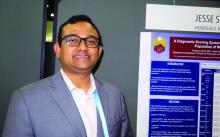User login
LOS ANGELES – Female sex and the absence of wheezing were the only factors significantly associated with vocal cord dysfunction in patients with high pretest probability of disease, a retrospective analysis showed.
The findings differ from those of the Pittsburgh Vocal Cord Index, which identified symptoms of throat tightness, dysphonia, absence of wheezing, and the presence of odors as key features predictive of vocal cord dysfunction (VCD). “This proves the point that VCD is an elusive diagnosis,” lead study author Phalgoon Shah, MD, said, in an interview, at the annual meeting of the American College of Chest Physicians.
The researchers found that a history of depression or anxiety, throat tightness, dysphonia, odor symptom trigger, lack of response to bronchodilator or truncation, and flattening of the inspiratory volume curve did not predict VCD.
The patients were active duty military personnel and veterans who were referred to the pulmonary function lab at Tripler Army Medical Center, Honolulu, for suspected VCD between 2010 and 2014. The researchers identified patients by laryngoscopy procedure code and collected numerous variables, including demographic information, past medical history, pulmonary function test data, and clinical variables such as ED visits for dyspnea.
Dr. Shah of the division of pulmonary and critical care at Tripler said that direct laryngoscopic visualization is used to diagnose VCD in military personnel because the diagnosis is grounds for dismissal, but in other practice settings, the technique is not readily available, even though it is considered the gold standard. “You might still have a very high clinical suspicion of VCD in spite of a negative laryngoscopy, and you send these patients to speech therapy and they get better,” he said. “By logic, you can assume that these patients had VCD, you just didn’t catch it right in the lab. For the first time, we are saying that exercise laryngoscopy is not the gold standard.”
He emphasized that more research is required to develop a validated scoring system to predict a diagnosis of VCD and to distinguish it from asthma. He reported having no financial disclosures.
LOS ANGELES – Female sex and the absence of wheezing were the only factors significantly associated with vocal cord dysfunction in patients with high pretest probability of disease, a retrospective analysis showed.
The findings differ from those of the Pittsburgh Vocal Cord Index, which identified symptoms of throat tightness, dysphonia, absence of wheezing, and the presence of odors as key features predictive of vocal cord dysfunction (VCD). “This proves the point that VCD is an elusive diagnosis,” lead study author Phalgoon Shah, MD, said, in an interview, at the annual meeting of the American College of Chest Physicians.
The researchers found that a history of depression or anxiety, throat tightness, dysphonia, odor symptom trigger, lack of response to bronchodilator or truncation, and flattening of the inspiratory volume curve did not predict VCD.
The patients were active duty military personnel and veterans who were referred to the pulmonary function lab at Tripler Army Medical Center, Honolulu, for suspected VCD between 2010 and 2014. The researchers identified patients by laryngoscopy procedure code and collected numerous variables, including demographic information, past medical history, pulmonary function test data, and clinical variables such as ED visits for dyspnea.
Dr. Shah of the division of pulmonary and critical care at Tripler said that direct laryngoscopic visualization is used to diagnose VCD in military personnel because the diagnosis is grounds for dismissal, but in other practice settings, the technique is not readily available, even though it is considered the gold standard. “You might still have a very high clinical suspicion of VCD in spite of a negative laryngoscopy, and you send these patients to speech therapy and they get better,” he said. “By logic, you can assume that these patients had VCD, you just didn’t catch it right in the lab. For the first time, we are saying that exercise laryngoscopy is not the gold standard.”
He emphasized that more research is required to develop a validated scoring system to predict a diagnosis of VCD and to distinguish it from asthma. He reported having no financial disclosures.
LOS ANGELES – Female sex and the absence of wheezing were the only factors significantly associated with vocal cord dysfunction in patients with high pretest probability of disease, a retrospective analysis showed.
The findings differ from those of the Pittsburgh Vocal Cord Index, which identified symptoms of throat tightness, dysphonia, absence of wheezing, and the presence of odors as key features predictive of vocal cord dysfunction (VCD). “This proves the point that VCD is an elusive diagnosis,” lead study author Phalgoon Shah, MD, said, in an interview, at the annual meeting of the American College of Chest Physicians.
The researchers found that a history of depression or anxiety, throat tightness, dysphonia, odor symptom trigger, lack of response to bronchodilator or truncation, and flattening of the inspiratory volume curve did not predict VCD.
The patients were active duty military personnel and veterans who were referred to the pulmonary function lab at Tripler Army Medical Center, Honolulu, for suspected VCD between 2010 and 2014. The researchers identified patients by laryngoscopy procedure code and collected numerous variables, including demographic information, past medical history, pulmonary function test data, and clinical variables such as ED visits for dyspnea.
Dr. Shah of the division of pulmonary and critical care at Tripler said that direct laryngoscopic visualization is used to diagnose VCD in military personnel because the diagnosis is grounds for dismissal, but in other practice settings, the technique is not readily available, even though it is considered the gold standard. “You might still have a very high clinical suspicion of VCD in spite of a negative laryngoscopy, and you send these patients to speech therapy and they get better,” he said. “By logic, you can assume that these patients had VCD, you just didn’t catch it right in the lab. For the first time, we are saying that exercise laryngoscopy is not the gold standard.”
He emphasized that more research is required to develop a validated scoring system to predict a diagnosis of VCD and to distinguish it from asthma. He reported having no financial disclosures.
AT CHEST 2016
Key clinical point:
Major finding: The only variables significantly associated with VCD were female sex (P = .006) and the absence of wheezing (P = .037).
Data source: A retrospective analysis of 244 patients referred to a pulmonary function lab for suspected VCD.
Disclosures: Dr. Shah reported having no financial disclosures.

